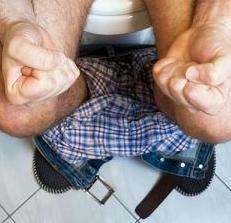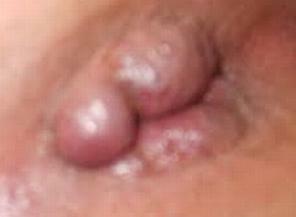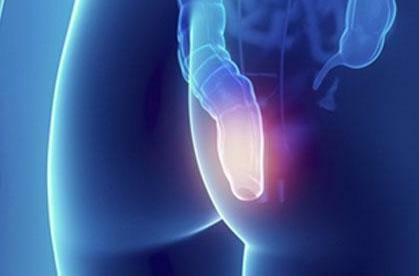 Pain in the anus is a feeling of discomfort in the area of the anus and rectum. There are many nerve endings here, so ulcers, cracks, overgrowths and other anomalies in this area are particularly painful.
Pain in the anus is a feeling of discomfort in the area of the anus and rectum. There are many nerve endings here, so ulcers, cracks, overgrowths and other anomalies in this area are particularly painful.
Pain can be caused or aggravated by diarrhea, constipation, too hard stools, often accompanied by severe itching and consequently leads to scratching, which irritates the skin and nerve endings.
The main diseases that cause pain in the anus are: hemorrhoids, thrombosis of hemorrhoids, prolapse of the rectum, paraproctitis, and also fractures of the anal canal. To sources of discomfort, sometimes painful, it is possible to refer and anal itching. However, many patients delay the visit to the doctor because of the embarrassment.
Remember - in the care of your own health, there is nothing reprehensible, and the lack of a doctor-chosen treatment can lead to the development of complications.
Causes of pain in the anus
Why does the anus hurt, and what should I do in this case? Pain in the anus is traditionally identified with hemorrhoids. Indeed, hemorrhoids are the most frequent, but not the only cause of pain in the anus in women and men. Besides this ailment, there are a number of diseases that give painful sensations in the area of the anus, perineum, sphincter.
In order to describe all causes of pain in the anus, consider those diseases that cause soreness in this area in men and women:
- hemorrhoids;
- anal fissures;
- proctitis;
- paraproctitis;
- prolapse of rectum;
- neoplasm;
- helminthiases;
- foreign bodies;
- injury.
In addition, the cause of pain in the anus can be a sedentary lifestyle for women and men. Especially often this phenomenon occurs in professional activities, requiring a long stay in a sitting position. In such situations, blood circulation in the pelvic and rectal zones is disturbed, which is immediately responded to by the nerve endings in the form of dull weak pain.
Pain in the anus after defecation
Pain after defecation is most likely a manifestation of a crack in the rectum. In this case, the disease is accompanied by a bleeding that occurs from the anus, there are spasmodic attacks affecting the sphincter. The pain at the appearance of a crack is short-lived, but the intensity is high. In most cases, a painful attack lasts about 20 minutes.
Also, pain after emptying is sometimes a sign of an anus cancer, although this symptom is not the first in this disease.
Symptoms of
Pain can be acute or blunt, burning or cutting;increases during or after defecation. Some people even avoid defecating, fearing pain.
Pain in the anus can be accompanied by:
- constipation or diarrhea;
- itching;
- by bleeding;
- abnormal discharge, such as pus;
- sensation of an extraneous body in the rectum, as in hemorrhoids.
After determining the causes of pain, the doctor will prescribe a treatment that removes discomfort and eliminates the cause.
Diagnosis
In the presence of pain in the anus, a consultation with the coloproctologist is required. The patient undergoes a complete examination, which allows to exclude the presence of diseases that manifest as pain in the anus.
A physical examination, an examination of the anus, a digital rectal examination. Rectoromanoscopy is performed for detailed examination of the rectum. If necessary, an irrigoscopy or a colonoscopy is performed.
Hemorrhoids
Hemorrhoids are an expansion of the veins of the rectum and the formation of nodes. The disease is very frequent, they suffer up to 10% of the entire adult population. The main causes of hemorrhoids - chronic constipation, standing or sedentary, inactive work, heavy physical work, alcohol abuse, frequent intake of acute irritating foods, repeated pregnancies.
Internal hemorrhoids can cause bleeding and "drop out" from the anus, but usually do not give pain. External nodes do not bleed, but can be thrombosed, at this time there are severe pain, itching in the anus.

Acute thrombosis of hemorrhoids
Blood circulation disorders lead to blood stasis, an increase in hemorrhoids, inability to correct them, edema and pain syndrome in the anus. Because of this, after a while, a thrombus forms in the node.
Symptoms of acute thrombosis are as follows:
- very severe pain in the anus;
- possible the appearance of hemorrhoids of dark red color;
- necrosis of the mucosa;
- bleeding;
- pain during defecation;
- edema in the anus.
Anal fissure
Anal fissure is a small rupture of the skin in the anus, which causes acute, dagger pain during bowel emptying. Pain is particularly painful when leaving a hard stool. An anal fissure is characterized by the release of a small amount of blood with feces or its traces on toilet paper( read more about rectal bleeding).
Often pain is given to the sacrum or perineum. Increased pain in the anus helps to increase the tone of the sphincter( spasm).Cracks develop in the presence of enterocolitis, hemorrhoids, sigmoiditis, proctitis.
Paraproctitis
Paraproctitis is an inflammatory process in the anus. The disease is caused by microbes that get through the combs, cracks or other injuries in the anus.
There is pain in the rectum area, the act of defecation is accompanied by soreness, a swelling appears in the buttocks and posterior sphincter. If the autopsy is not performed in time, o it can break out and lead to the formation of a fistula, and, as a consequence, the chronicity of the disease.
Paraproctitis
Paraproctitis is an inflammatory process in the anus. The disease is caused by microbes that get through the combs, cracks or other injuries in the anus.
There is pain in the rectum area, the act of defecation is accompanied by soreness, a swelling appears in the buttocks and posterior sphincter. If the autopsy is not performed in time, o it can break out and lead to the formation of a fistula, and, as a consequence, the chronicity of the disease.
Parasites
Helminthiases, that is, parasitic diseases, cause the appearance of anal pain of varying intensity. These pains are often combined with a sensation of itching and burning, periodic constipation, fever, a general malaise, a rash and traces of scrapings on the skin of the perineum.
Injury to the rectum
May occur due to elevation of gravity, constipation, childbirth, falling on a protruding subject, improper conduct of diagnostic measures, unconventional sexual contact, damage to bone fragments, the presence of gunshot wounds or cut wounds.

Cancer of the anal canal
The onset of the disease occurs with symptoms such as discomfort, mucus, blood, anal itching. That is, symptoms are common to various diseases of the rectum and the anal canal, so early diagnosis is of primary importance in the treatment of the disease.
How to treat pain in the anus
Be sure to consult a doctor if:
- you have found spotting from the anus in a dark red or brown;
- stool is tarry, black or rust colored;
- in your family had cases of cancer of the colon or rectum;
- pain is severe or lasts more than a week.
Determining the cause of the disease is important for choosing further tactics for treating pain in the anus in a woman or a man. A timely diagnosis will allow the appointment of etiotropic drugs that help to eliminate the cause of the disease. These can be:
- preparations that affect the condition of the veins,
- antibiotics,
- haemostatic agents,
- antiplatelet agents and other agents.
The tactics of treatment are determined by the physician and depends on the disease with which the pain syndrome is associated.

How to choose probiotics for the intestines: a list of drugs.

Effective and inexpensive cough syrups for children and adults.

Modern non-steroidal anti-inflammatory drugs.

Review of tablets from the increased pressure of the new generation.
 Antiviral drugs are inexpensive and effective.
Antiviral drugs are inexpensive and effective.



